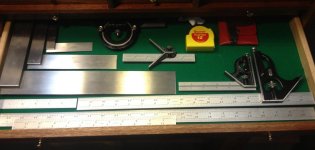I wanted to post what I learned from this thread and my experience with my mill.
As we always say here, the cost of the machinery is often not the majority of the cost of setting up a machine shop. Our common “required tools" lists typically include the stuff an apprentice would bring to work. The list below attempts to identify all the tools one would need for a new milling machine. It includes tools the apprentice would expect to find on his first day. Viewed as a whole, this could easily be $10,000 of tools.
My advice is to start with the inspection tools and buy second hand. Inspect what you buy, new and old. Inspection should not be an after thought. Its an important skill. If you leave yourself enough time, you can often find what you need locally for pennies on the dollar.
I've tried to divide the tools into categories that I hope will be helpful. I'm looking forward to your comments, especially anything you think I missed.
Inspection tools:

(I'm using an old Starrett #57 gage to hold a pretty modern digital indicator to measure the depth of flaking on a BP column. Surface gages are useful tools for a wide array of applications.)

(Pros on PM generally prefer Interapid DTIs with their unique slanted faces and integrated stems.)

(I have one of these, which technically could serve as both a tenths (.0001") and a thousandths (.001") reading indicator, eliminating a set up change between rough tramming and final tramming. One thoughtful feature is that when you touch it to zero, the device delays the actual reset to allow you to get your hand away. As cool as this tool is, I don't find I use it that much.)

(The Noga fine adjustment head's dovetail holder (right hand side) doesn't fit Chinese indicators I've seen. More, the clamp holes are 3/8", 8mm, and 6mm. Chinese indicators frustratingly ship with 10mm and 4mm stems. So just be aware when choosing an indicator that it will work with all of your other tools. Interapid also uses a 4mm stem, but at least its dovetails are standard.)
As we always say here, the cost of the machinery is often not the majority of the cost of setting up a machine shop. Our common “required tools" lists typically include the stuff an apprentice would bring to work. The list below attempts to identify all the tools one would need for a new milling machine. It includes tools the apprentice would expect to find on his first day. Viewed as a whole, this could easily be $10,000 of tools.
My advice is to start with the inspection tools and buy second hand. Inspect what you buy, new and old. Inspection should not be an after thought. Its an important skill. If you leave yourself enough time, you can often find what you need locally for pennies on the dollar.
I've tried to divide the tools into categories that I hope will be helpful. I'm looking forward to your comments, especially anything you think I missed.
Inspection tools:
- Surface plate- buy the biggest you can afford or move. Big plates are sometimes surprisingly cheap second hand, maybe because amateurs don't want to move them and pros want recent calibrations. A 18X24 is about 150lbs and can be moved by 2 working men. The next size up, 24X36 is over 3X heavier.
- Master square – could be a cylinder square, Starrett #20, granite square, angle plate or just a trustworthy 123 block.

(I'm using an old Starrett #57 gage to hold a pretty modern digital indicator to measure the depth of flaking on a BP column. Surface gages are useful tools for a wide array of applications.)
- Surface gage (or height gage) for marking and to mount a Dial Test Indicator (DTI) on to check parallelism against the surface block.
- Matched Vee blocks - for round pieces
- Thick parallels to elevate parts above the surface plate. Matched 123 blocks can be used. Real inspectors often use cylindrical gage blocks that they almost always call “jo blocks”. (Jo refers to Johansson, a brand of gage blocks). These are also often used in conjunction with a sine plate.

(Pros on PM generally prefer Interapid DTIs with their unique slanted faces and integrated stems.)

(I have one of these, which technically could serve as both a tenths (.0001") and a thousandths (.001") reading indicator, eliminating a set up change between rough tramming and final tramming. One thoughtful feature is that when you touch it to zero, the device delays the actual reset to allow you to get your hand away. As cool as this tool is, I don't find I use it that much.)

(The Noga fine adjustment head's dovetail holder (right hand side) doesn't fit Chinese indicators I've seen. More, the clamp holes are 3/8", 8mm, and 6mm. Chinese indicators frustratingly ship with 10mm and 4mm stems. So just be aware when choosing an indicator that it will work with all of your other tools. Interapid also uses a 4mm stem, but at least its dovetails are standard.)
- Dial Test Indicators (DTI) 0-30-0 X.001” and 0-5-0X.0001” or metric equivs. Buy Japanese, US or Swiss to ensure compatibility with most indicator attachments (like Noga).
- Micrometer(s)- lots of advice on PM
- Caliper -lots of advice on PM
- Gage Block Set- doesn't need to be highest grade, may not even need complete set
- Machinist’s level – can be used to detect twist in a part, not just for leveling machines
- T-slot, Hole gages, Radius gages, Feeler and Thread gages
Last edited:













